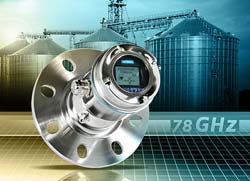The first 78 GHz radar level transmitter for solids level measurement

The Siemens Industry Automation Division launches the first radar level transmitter with a frequency of 78 GHz. The device is equipped with a newly developed lens antenna and uses the non-contacting FMCW technology.<br>
Sitrans LR560 is a non-contacting 2-wire FMCW (Frequency Modulated Continuous Wave) radar level measurement transmitter with a measurement range of 100 meters (328 ft). The transmitter emits a narrow four degree beam which avoids silo wall obstructions and other installation interferences, allowing it to be installed practically anywhere on the top of the silo.
As the first radar transmitter to operate at 78 GHz frequency, it emits a short wavelength to provide exceptional signal reflection even from solids with a steep angle of repose. The graphical Quick Start Wizard guides the user to get Sitrans LR560 operational in minutes for accurate and reliable level measurement readings without any additional fine-tuning.
Sitrans LR560 is available with HART®, PROFIBUS PA, or FOUNDATION™ Fieldbus protocol. Programming is supported locally with pushbuttons or with an infrared handheld programmer. The transmitter also supports remote configuration and diagnostics with Siemens Simatic PDM (Process Device Manager), Emerson AMS™, or PACTware™ using Siemens DTM. The local display interface features a backlit display and can be rotated to four positions for convenience. The unique lens antenna is highly resistant to material build-up and an integrated purge connection is included for cleaning exceptionally sticky solids material. The high frequency operation makes aiming unnecessary, but the optional aiming flange helps direct the beam to an area of specific interest, such as the discharge area of the silo cone.
For technical details please contact:Siemens Milltronics, Henry Vandelinde, henry.vandelinde@siemens.com
Tel: +1 (705) 740-7643
The Siemens Industry Sector (Erlangen, Germany) is the worldwide leading supplier of environmentally friendly production, transportation, building and lighting technologies. With integrated automation technologies and comprehensive industry-specific solutions, Siemens increases the productivity, efficiency and flexibility of its customers in the fields of industry and infrastructure. The Sector consists of six divisions: Building Technologies, Drive Technologies, Industry Automation, Industry Solutions, Mobility and Osram. With around 204,000 employees worldwide (September 30), Siemens Industry achieved in fiscal year 2010 total sales of approximately €34.9 billion. http://www.siemens.com/industry
The Siemens Industry Automation Division (Nuremberg, Germany) is a worldwide leader in the fields of automation systems, industrial controls and industrial software. Its portfolio ranges from standard products for the manufacturing and process industries to solutions for whole industrial sectors that encompass the automation of entire automobile production facilities and chemical plants. As a leading software supplier, Industry Automation optimizes the entire value added chain of manufacturers – from product design and development to production, sales and a wide range of maintenance services. With around 33,000 employees worldwide (September 30), Siemens Industry Automation achieved sales of €6.2 billion in fiscal year 2010. http://www.siemens.com/industryautomation
Reference Number: IIA2011022612e
Media Contact
More Information:
http://www.siemens.com/sitranslr560All latest news from the category: Machine Engineering
Machine engineering is one of Germany’s key industries. The importance of this segment has led to the creation of new university degree programs in fields such as production and logistics, process engineering, vehicle/automotive engineering, production engineering and aerospace engineering among others.
innovations-report offers informative reports and articles covering technologies such as automation, motion, power train, energy, conveyor, plastics, lightweight construction, logistics/warehousing, measurement systems, machine tools and control engineering.
Newest articles

A universal framework for spatial biology
SpatialData is a freely accessible tool to unify and integrate data from different omics technologies accounting for spatial information, which can provide holistic insights into health and disease. Biological processes…

How complex biological processes arise
A $20 million grant from the U.S. National Science Foundation (NSF) will support the establishment and operation of the National Synthesis Center for Emergence in the Molecular and Cellular Sciences (NCEMS) at…

Airborne single-photon lidar system achieves high-resolution 3D imaging
Compact, low-power system opens doors for photon-efficient drone and satellite-based environmental monitoring and mapping. Researchers have developed a compact and lightweight single-photon airborne lidar system that can acquire high-resolution 3D…





















